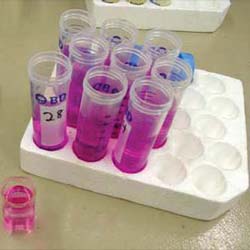Quick Reference Guide: Potassium Permanganate Test for Active Carbon
Decomposition | Forms and Function | Management of Soil Organic Matter | Carbon Cycle
Download the PDF version of this document: Quick Reference Guide: Potassium Permanganate Test for Active Carbon (PDF 164KB)
To view the information PDF requires the use of a PDF reader. This can be installed for free from the Adobe website (external link).
An output of the ‘Soil Health for Sustainable and Productive Landscapes’ Project
Active carbon is an indicator of the fraction of soil organic matter that is readily available as a carbon and energy source for the soil microbial community (i.e., food for the soil food web). The soil is mixed with potassium permanganate (deep purple in colour) and as it oxidizes the active carbon the colour changes (becomes less purple), which can be observed visually, but is very accurately measured with a spectrophotometer.
Basic Protocol
- Collect soil samples (try to pick a “good” and “not so good” sample in terms of the organic carbon content) and allow to air dry (soil can be crumbled into a petri dish then dried in the sun for a few minutes). The soil should be ground to give fairly even aggregate consistency between samples and sieved to 2 mm (but not essential)
- About 5 g sample of air-dried soil is placed in a 50 ml tube and filled with 35 ml of a 0.02 M potassium permanganate (KMnO4) solution, which is deep purple in colour
- The soil and KMnO4 are shaken for 2-10 minutes to oxidize the “active” carbon in the sample. The purple colour becomes lighter as a result of this oxidation. Compare colour changes between samples. Less purple indicates more active carbon
- (Optional) The sample is centrifuged for 5 minutes, and the supernatant is diluted with distilled water and measured for absorbance at 550 nm. The absorbance of a standard dilution series of the KMnO4 is also measured to create a calibration curve for interpreting the sample absorbance data. A simple formula is used to convert sample absorbance value to active C in units of mg carbon per kg of soil
| How active C relates to soil Research has shown that active carbon is highly correlated with and similar to “particulate organic matter, which is determined with a more complex and labour intensive wet-sieving and/or chemical extraction procedure. Active carbon is positively correlated with percent organic matter, aggregate stability, and with measures of biological activity such as soil respiration rate. Research has shown that active carbon is a good “leading indicator” of soil health response to changes in crop and soil management, usually responding to management much sooner (often, years sooner) than total organic matter percent. Thus, monitoring the changes in active carbon can be particularly useful to farmers who are changing practices to try to build up soil organic matter (e.g., reducing tillage, using new cover crops, and adding new composts). |  Figure 1. Sample tubes containing potassium permanganate solution |
Reference
Gugino BK, Idowu OJ, Schindelbeck HM, van Es HM, Wolfe DW, Thies JE, Abawi GS (2007) Cornell soil health assessment training manual. NYSAES, Geneva, New York.


